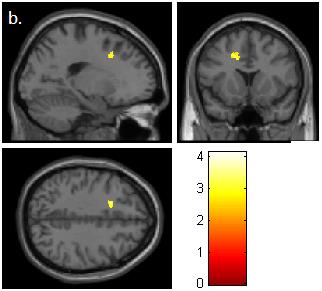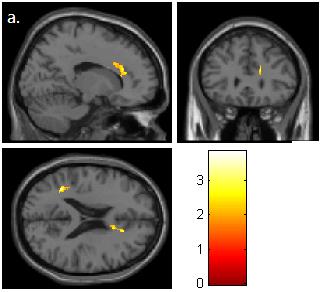2316
Quantitative evaluation of brain volume change after phthalate esters exposure using voxel-based morphometry1Department of Medical Imaging and Radiological Sciences, Chung Shan Medical University, Taichung, Taiwan, 2Department of Medical Imaging, Chung Shan Medical University Hospital, Taichung, Taiwan, 3School of Medicine and Department of Pediatrics, Chung Shan Medical University and Hospital, Taichung, Taiwan, 4Institute of Medicine, Chung Shan Medical University, Taichung, Taiwan, 5National Institute of Environmental Health Sciences, National Health Research Institutes, Miaoli, Taiwan
Synopsis
The products made by phthalate esters could be found everywhere. But there were only a few studies mentioned about the influence of phthalate esters exposure on brain volume. We used the voxel-based morphometry analysis to observe the correlation between the concentrations of maternal urine phthalate esters (MBP, MBzP, DEHP, MEHP, MEOHP) and children’s brain volume of gray and white matter. We found the negative correlation between the concentrations and the volume of frontal gyrus and cingulate gyrus.
Introduction
Phthalate esters were played important roles in our life for long times. Many items were made by them, such as food containers, building materials, medical equipment. We seldom noticed the influence of phthalate esters exposure on the brain. The previous study showed the correlation between the concentrations of urine phthalate esters and Child Behavior Checklist (CBCL) scores1. However, no study mentioned about the correlation between the concentrations and brain volume. We tried to find the correlation between children’s brain volume and the concentrations of five kinds of maternal urine phthalate esters, including metabolite monobutyl phthalate (MBP), monobenzyl phthalate (MBzP), di (2-ethylhexyl) phthalate (DEHP), mono-2-ethylhexyl phthalate (MEHP) and mono-2-ethyl-5-oxohexyl phthalate (MEOHP), using voxel-based morphometry (VBM) analysis.Materials and Methods
In the study, we examined the association between phthalate esters in the maternal urine collected during the third trimester of pregnancy and the children's brain MRI at 13 to 16 years of age. Forty-eight children were arranged for MRI whole brain examination on a 3T imaging system (Skyra, Siemens, Germany). Magnetization Prepared Rapid Gradient Echo Imaging (MPRAGE) sequence was used to obtained T1 weighted images for VBM analysis. Images were acquired with the following parameters: TR = 2500 ms, TE = 2.27 ms, TI = 902 ms, voxel size = 1 x 1 x 1 mm3, and scan time = 5.8 min. In VBM analysis, all structural data were processed using Statistical Parametric Mapping 8 (SPM8, Wellcome Department of Cognitive Neurology, London, UK) with Voxel-Based Morphometry 8 (VBM8, University of Jena, Department of Psychiatry, Jena, Germany) toolbox. Each raw data was first normalization to International Consortium for Brain Mapping (ICBM) templates, East Asian Brain. Subsequently, whole-brain T1-weighted images were segmented into gray matter and white matter. Then, multiple regression was used the obtain the correlation between the concentrations of maternal urine phthalate esters (MBP, MBzP, DEHP, MEHP, MEOHP) and children’s brain volume of gray and white matter. To avoid the original difference of each brain, sex, and whole brain volume were used as covariates.Results
We observed a negative correlation between the urine concentrations (MBP, MBzP, DEHP, MEHP, MEOHP) and brain volume in the frontal gyrus. We also found a negative correlation between the urine concentrations (DEHP, MEOHP) and brain volume in cingulate gyrus. Above two results were both statistically significant (corrected p < 0.05).Discussion
We found that the higher urine concentration of maternal urine phthalate esters, the more reduced children’s brain volume in frontal gyrus and cingulate gyrus. The function of cingulate cortex is emotional and social cognition, and the function of frontal lobe is voluntary movement control. The previous study showed phthalate esters probably resulted in children with some emotional or behavior problems, such as anxiety, depressed, aggressive behavior1. Two studies indicated aggressive problem affect the cortical thickness in frontal and anterior cingulate cortex2,3. The previous study also showed that participants with intermittent explosive disorder (IED) had reduction FA in frontal gyrus4. In addition, the previous study found the urine concentration (DEHP) in children with ADHD was higher than in children without ADHD5, and the cortical thickness of frontal lobe in children with ADHD was thinner than in children without ADHD5.Conclusion
In our result, we observed the negative correlation of the concentrations of urine phthalate esters and the volume of frontal gyrus and cingulate gyrus. Above two brain area atrophy could cause children in behavior or emotional problem later in their lives. The result could let people value the issue of phthalate esters exposure, and encourage to find out the solution for reducing the exposure in our life as soon as possible.Acknowledgements
This study was supported in part by the nationwide Taiwan Maternal and Infant Cohort Study.References
1. Lien YJ, Ku HY, Su PH, et al. Prenatal Exposure to Phthalate Esters and Behavioral Syndromes in Children at 8 Years of Age: Taiwan Maternal and Infant Cohort Study. Environmental Health Perspectives. 2015; 123(1): 95-100.
2. Thijssen S, Ringoot AP, Wildeboer A, et al. Brain morphology of childhood aggressive behavior: A multi-informant study in school-age children. Cogn Affect Behav Neurosci. 2015; 15: 564–577.
3. Ducharme S, Hudziak JJ, Botteron KN, et al. Right Anterior Cingulate Cortical Thickness and Bilateral Striatal Volume Correlate with CBCL Aggressive Behavior Scores in Healthy Children. Biol Psychiatry. 2011; 70(3): 283–290.
4. Lee R, Arfanakis K, Evia AM, et al. White Matter Integrity Reductions in Intermittent Explosive Disorder. Neuropsychopharmacology. 2016; 41(11): 2697-703.
5. Park S, Lee JM, Kim JW, et al. Association between phthalates and externalizing behaviors and cortical thickness in children with attention deficit hyperactivity disorder. Psychological Medicine. 2015; 45: 1601–1612.

